- Home
- Terry Pratchett
The Folklore of Discworld Page 12
The Folklore of Discworld Read online
Page 12
This myth is hard to believe. The distribution of land masses on the Earth is so untidy that no dragon could encircle the whole planet while lying on the seabed without suffering painful and possibly fatal dislocations of its spine. However, somewhere there exists another universe which was once briefly summoned into a prism by the gifted young wizard Simon, and this one does appear to contain a Middle-Earth Worm.
A prism … held another slowly turning disc, surrounded by little stars. But there were no ice walls around this one, just a red-gold thread that turned out on closer inspection to be a snake – a snake big enough to encircle a world. For reasons best known to itself it was biting its own tail. [Equal Rites]
This is confirmed by something the sea-troll Tethis told Rincewind (see The Colour of Magic). While tumbling through space after being swept off the edge of his own world, Tethis passed within a few leagues of a world with a strange ring of mountains round it – mountains that turned out to be ‘the biggest dragon you could ever imagine, covered in snow and glaciers and holding its tail in its mouth’. A dim awareness of this universe may explain the Earth myth of Draco maritimus immensis, and also the image of the ouroboros or tail-biting serpent known to alchemists and hermetic philosophers as the symbol of the ever-circling eternity of time and space.
THE BASILISK AND THE CHIMERA
The basilisk is a particularly dangerous species of serpent, which can kill any other animal merely by glancing at it with its fierce, fell and fiery eyes; its breath destroys all vegetation, so it is necessarily a desert-dweller; its blood is said to be of great value to magicians. On Earth, it was first identified by the Ancient Greeks, who gave it a name meaning ‘little king’, because (as the Roman naturalist Pliny explained) it has a golden mark like a crown on its head.
Later, during the Middle Ages of western Europe, people believed that it wore an actual coronet of pure gold, and some described it as a snake with four pairs of legs. They gave it a second name, ‘cockatrice’, and said it was a mortal enemy of crocodiles. They also claimed to know how it is born: when a farmyard cock lives longer than is normal for his species, in the last stage of his life he starts to lay eggs, and if, in the hottest days of summer, some venomous serpent or toad coils itself round such an egg and hatches it, what comes out is the cockatrice or basilisk. It has the head and legs of a cockerel, but its body tapers down to a snake’s tail, ending in a dart. It was much feared for its death-dealing glance, until a method of destroying it was devised. Writing a Historie of Serpents in 1608, the naturalist Edward Topsell mocked the legend:
I cannot without laughing remember the old wives’ tales of the vulgar cockatrices that have been in England, for I have often-times heard it confidently related, that once our nation was full of cockatrices, and that a certain man did destroy them by going up and down in glasse, whereby their own shapes were reflected upon their own faces, and so they died.
Topsell was wrong to laugh. The method is perfectly valid. It exploits an instinct which can also be seen in young male swamp dragons in the breeding season, when they are so eager to drive off a rival that they will attack their own reflections (as Chubby did in Men at Arms).
On the Discworld, the basilisk inhabits the burning deserts of Klatch. On one occasion, as we read in Sourcery, a hungry basilisk which lay panting in the baking shade of a rock, dribbling corrosive yellow slime, heard the thumping of hundreds of little feet. This, the creature thought, must mean that its dinner was on the way. But what was approaching was the wizard Rincewind’s fearsome Luggage, which was in a particularly foul mood because it had become separated from its master and had recently had to fight its way across a river infested with alligators.
The basilisk blinked its legendary eyes and uncoiled twenty feet of hungry body, winding out and on to the sand like fluid death.
The Luggage staggered to a halt and raised its lid threateningly. The basilisk hissed, but a little uncertainly, because it had never seen a walking box before, and certainly never one with lots of alligator teeth stuck in its lid. There were also scraps of leathery hide adhering to it, as though it had been involved in a fight in a handbag factory, and in a way that the basilisk wouldn’t have been able to describe even if it could talk, it appeared to be glaring.
Right, the reptile thought, if that’s the way you want to play it.
It turned on the Luggage a stare like a diamond drill, a stare that nipped in via the staree’s eyeballs and flayed the brain from the inside, a stare that tore the frail net curtains on the windows of the soul, a stare that—
The basilisk realized something was very wrong. An entirely new and unwelcome sensation started to arise just behind its saucer-shaped eyes. It started small, like the little itch in those few square inches of back that no amount of writhing will allow you to scratch, and grew until it became a second, redhot, internal sun.
The basilisk was feeling a terrible, overpowering and irresistible urge to blink …
It did something incredibly unwise.
It blinked. [Sourcery]
The Luggage went on its way, with a few traces of yellow slime rapidly drying on its lid. What a tragic misunderstanding! If only the basilisk had been less hungry that day, and the Luggage less ill-tempered, they would have seen how much they had in common – a domineering gaze, a dislike of alligators and crocodiles, perhaps even a multiplicity of feet, if some pictures of basilisks can be trusted. A beautiful friendship might have been born. But it was not to be.
Pursuing its erratic course across the dunes of Klatch, the Luggage next encountered a Chimera, which was sitting on a stone pinnacle the shape and temperature of a firebrick. Before recounting the outcome, it will be useful to see what books from our own world can tell about this monster – legendary here, but real enough on the Discworld.
According to John Milton, a chimera is just about the worst thing you could meet on a guided tour of Hell. In Book 2 of his Paradise Lost he lists the horrors in the infernal landscape at some length, and caps them all with the assertion that Hell is a place
Where all life dies, death lives, and Nature breeds (Perverse) all monstrous, all prodigious things, Abominable, inutterable, and worse Than fables yet have feigned, or fear conceived, Gorgons, and Hydras, and Chimaeras dire.
After which it comes as a bit of a let-down to find that, according to Ancient Greek poets, the Chimera was a rather muddled female monster, consisting of a fire-breathing nanny-goat with a lion’s head and a snake’s body. An alternative view, supported by Ancient Greek artists who had to draw the damn thing, was that she had two heads at the front end, one leonine and one capriform, and a long scaly tail at the back end, terminating in a snake’s head. The Greek Chimera’s family was an unpleasant one. Her father Typhon, the god of storms at sea, was nothing but a writhing mass of serpents from the waist down, and had snakes instead of fingers, while his wings darkened the whole sky; her mother was a sea-monster, half woman and half snake, who ate humans raw; her siblings included Cerberus, the three-headed Hound of Hell, and the hundred-headed Hydra.
The Greek Chimera did her best to be dire; she tried to look as abominable and inutterable as she could, but the goat component undermined the effect. Her biggest asset was her fiery breath, yet even this turned out to be unhelpful when the hero Bellerophon was sent to kill her, on the orders of an enemy of his, who assumed this was a mission impossible – indeed, fatal. But Bellerophon was as canny as he was good-looking, and devised a cunning plan. Mounted on his good flying horse Pegasus, he swooped over the Chimera, firing arrows at her, and when she opened her lion’s jaws to puff flame at him he dropped a lump of lead down her throat. The heat of her stomach melted the lead, sealing her doom from the inside.
The chimera of the Discworld may be related, but separate evolution has brought about several differences, including some unexpected wings. According to Broomfog’s bestiary Anima Unnaturale,
It have thee legges of an mermade, the hair of an tortoise, the teeth of an fow
el, and the winges of an snake. Of course, I have only my worde for it, the beast having the breathe of an furnace and the temperament of an rubber balloon in a hurricane. [Sourcery]
Such was the creature which attacked Rincewind’s Luggage.
The chimera’s technique was to swoop low over the prey, lightly boiling it with its fiery breath, and then turn and rend its dinner with its teeth. It managed the fire part but then, at the point where experience told the creature it should be facing a stricken and terrified victim, found itself on the ground in the path of a scorched and furious Luggage.
The only thing incandescent about the Luggage was its rage. It had spent several hours with a headache, during which it seemed the whole world had tried to attack it. It had had enough.
When it had stamped the unfortunate chimera into a greasy puddle on the sand, it paused for a moment, apparently considering its future … [Sourcery]
There is a distinct possibility that the Discworld chimera, always an endangered species, is now extinct.
THE SPHINX
Though there can be no doubt that Prince Teppic of Djelibeybi once met a Sphinx, there has been much argument over whether the creature is truly part of the Discworld’s fauna. Teppic himself was unclear as to where he was when he encountered it. Space and time had been behaving strangely. A spokesman for Unseen University expressed the view that:
The Sphinx is an unreal creature. It exists solely because it has been imagined. It is well known that in an infinite universe anything that can be imagined must exist somewhere, and since many of them are not things that ought to exist in a well-ordered space-time frame they get shoved into a side dimension. [Pyramids]
To which Teppic replied that that’s as may be, but he was in no doubt that either he broke into the Sphinx’s dimension or it broke into his, and that what has happened once may happen again. Provisionally, therefore, the Sphinx has been listed as a potential (if unwelcome) denizen of the Discworld.
On Earth, its existence is better documented. According to ancient writers, a Sphinx is a creature with the body of a lion or lioness and a human head; one subspecies has wings and human female breasts; another has a serpent’s tail; yet another exists only in the form of conjoined twins. The name means ‘throttler’ in Greek. They were native to Egypt, where they guarded the borders of the kingdom, the entrances to temples, and the approaches to important pyramids and tombs. They were not normally dangerous to humans. Many statues of them were made, and can be seen to this day.
The Egyptians themselves had no generic word for sphinxes, each one (and there were hundreds of them) having a name of its own. Tourists visiting the Great Sphinx of Giza should address it, cautiously, as Horemakhet Khepri-Ra-Atum. If they get the pronunciation right, it may choose to reveal some of the hidden treasures which it guards. If they get it wrong, it may choose to reveal its claws.
The Great Sphinx of Giza has two aims in its existence. The first is to guard the royal tombs at Memphis, which it has successfully done for some 4,500 years; the second is to keep itself, and the town of Giza, free from drifting sand, because sand makes it ache in all its limbs. This has been a sorry failure. After a mere eleven hundred years it was buried in dunes right up to the neck, until it was dug clear by Prince Thutmose, whom it gratefully made Pharaoh. Other people have had to dig it out again since then, but they don’t now get to be made Pharaoh. In fact, the Great Sphinx seems to have pretty well given up on its sand-repelling duties, allowing Giza to be engulfed, and relying on humans to give it the occasional brush-up. The Arabs say it is sulking because a holy man smashed its nose.
According to Greek mythology, the goddess Hera brought a single female sphinx from Egypt to Greece, for vindictive reasons; she must have hoped that, as so often, the introduction of a foreign species would seriously damage the local ecology, but since she neglected to provide it with a mate it did not breed, and the devastation it caused ended with its life.
This Greek Sphinx was more active, more malevolent, than her Egyptian relatives. She perched herself on a rock overlooking the main road into Thebes, where she forced every traveller to try to guess her utterly perplexing Riddle: ‘What animal walks on four legs in the morning, two at midday, and three in the evening, and is at its weakest when it has most legs?’ If they couldn’t answer, she throttled them, and ate them. And so it went on, until one day Oedipus came along, and replied, ‘That animal is Man. As a feeble baby, he crawls on all fours; as an adult, he walks upright; as an old man, he uses a stick.’ The Sphinx was so furious that she beat her brains out against the rock.
Prince Teppic’s Sphinx, like the Egyptian one, guarded a border – in this case, a fold in the space-time continuum which was a border between dimensions. Like the Greek one, it relied upon The Riddle to provide it with entertainment and with innumerable meals. Now Teppic, despite being a fully qualified Assassin, was not a man of violence, and had a proper concern for wildlife, even in its more alarming forms. He tried polite conversation (‘We’ve got any amount of statues to you at home’), but the Sphinx, though flattered, could not be sidetracked for long, and challenged him with its Riddle. Teppic admitted defeat, so the gloating Sphinx itself gave him the explanation.
Now, Teppic had been born into a culture profoundly distrustful of metaphors, symbolism, allegories, and figures of speech of every sort. The people of Djelibeybi took all religious, poetic, and metaphysical statements as literal physical truths; to them, a metaphor was a lie. Furthermore, Teppic had recently visited Ephebe, where he had heard the philosopher Xeno expounding his famous logical proof that if you shoot an arrow at a tortoise you cannot possibly hit it.
So Teppic launched an attack, not on the Sphinx, but on its metaphor. Combining the deadly literalism of Djelibeybi with the debating skills and logic of Ephebe, he demanded clarifications. Did all this actually happen in one day, to one individual? Well, no, the Sphinx admitted, it is a figure of speech, but what’s wrong with that? ‘An element of dramatic analogy is present in all riddles,’ it claimed. ‘Yes, but,’ said Teppic, ‘is there internal consistency within the metaphor?’ Step by step, the hapless Sphinx was forced to concede that in an analogy where the human lifespan of seventy years is represented by twenty-four hours, the crawling stage only lasts for about twenty minutes, and can’t be called ‘morning’, as it comes just after midnight. There are other problems too. Since some old folk need no sticks while others use two, would it not be more accurate to say that after supper-time ‘it continues to walk on two legs or with any prosthetic aids of its choice’?
When everything had been settled to their mutual satisfaction, the Sphinx repeated its challenge. But of course Prince Teppic already knew the answer. The Sphinx itself had told him, earlier on. He now gave it, and the Sphinx had to let him go free. He got away just in time as an angry bellow erupted behind him, when the Sphinx finally worked out what had happened.
Should the creature ever reappear on the Discworld or in our own universe, people will now know how to deal with it.
THE PHOENIX
Everyone agrees that the phoenix, also known as the firebird, is extremely beautiful, and that it is the rarest bird that has ever existed, or could ever exist, anywhere in the multiverse. It’s said, both on the Discworld and on Earth, that you only get one phoenix at a time, that it lives to be five hundred years old, and that when it feels its death approaching it builds a nest, in which it lays a single egg. Then it bursts into flame and burns itself up, so that the warmth will hatch out the new bird from the ashes. This way of life, and death, makes it extremely useful as an allegory or metaphor. It also makes some people think that it is only a mythical creature.
However, there are people in Lancre who, having observed nature closely, think the commonly accepted story cannot be accurate. Both Hodgesaargh the falconer and Granny Weatherwax have found the occasional phoenix feather, a small flickering flame-like thing which nothing can quench. Granny keeps hers in a little glass bottle. One day the other
witches are examining it:
‘I saw her pick that thing up years ago,’ said Magrat. ‘It was around this time of year, too. We were walking back through the woods and there was a shooting star and this sort of light fell off it and we went to look and there it was. It looked like a flame but she was able to pick it up.’
‘Sounds like a firebird feather,’ said Nanny. ‘There used to be old stories about them. They pass through here. But if you touch their feathers you’d better be damn sure of yourself, because the old stories say they burn in the presence of evil—’
‘Firebird? You mean a phoenix?’ said Agnes.
‘Haven’t seen one go over for years,’ said Nanny. ‘Sometimes you’d see two or three at a time when I was a girl, just lights flying high up in the sky.’
‘No, no, the phoenix … there’s only one of it, that’s the whole point,’ said Agnes.
‘One of anything’s no bloody use,’ said Nanny. [Carpe Jugulum]
On the Discworld, the firebird is said to have its main home in the hot deserts of Klatch, even though its seasonal migrations take it over Lancre. So, the best place to look for its equivalent on Earth would be in the hot deserts of Ancient Egypt. And there, sure enough, it is – not yet called the phoenix, but the Benu Bird. The name probably means ‘rise-and-shine’. According to one Egyptian myth it is the oldest of all creatures; its cry was the first sound ever heard, when it perched, glowing, on the first mound of earth to rise up out of the primeval sea – or, others said, on the first sacred obelisk, the Benben stone at Heliopolis. It was usually described as a heron, or as a huge golden hawk with a heron’s beak.

 Feet of Clay
Feet of Clay The Color of Magic
The Color of Magic Thud!
Thud! Good Omens: The Nice and Accurate Prophecies of Agnes Nutter, Witch
Good Omens: The Nice and Accurate Prophecies of Agnes Nutter, Witch I Shall Wear Midnight
I Shall Wear Midnight Mort
Mort Raising Steam
Raising Steam Guards! Guards!
Guards! Guards!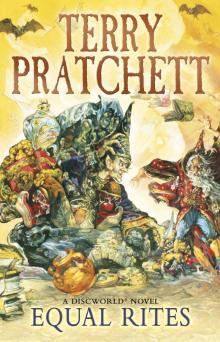 Equal Rites
Equal Rites A Hat Full of Sky
A Hat Full of Sky The Light Fantastic
The Light Fantastic Mrs Bradshaw's Handbook
Mrs Bradshaw's Handbook Wyrd Sisters
Wyrd Sisters Soul Music
Soul Music Small Gods
Small Gods Sourcery
Sourcery Reaper Man
Reaper Man Night Watch
Night Watch Lords and Ladies
Lords and Ladies The Fifth Elephant
The Fifth Elephant Monstrous Regiment
Monstrous Regiment The Truth
The Truth Witches Abroad
Witches Abroad Eric
Eric Going Postal
Going Postal Men at Arms
Men at Arms Jingo
Jingo The Amazing Maurice and His Educated Rodents
The Amazing Maurice and His Educated Rodents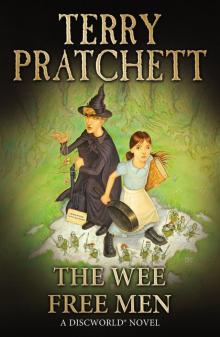 The Wee Free Men
The Wee Free Men Pyramids
Pyramids Wintersmith
Wintersmith Moving Pictures
Moving Pictures Carpe Jugulum
Carpe Jugulum Interesting Times
Interesting Times Maskerade
Maskerade Making Money
Making Money The Shepherd's Crown
The Shepherd's Crown Hogfather
Hogfather Troll Bridge
Troll Bridge The Last Continent
The Last Continent The Sea and Little Fishes
The Sea and Little Fishes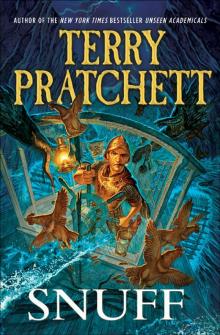 Snuff
Snuff Unseen Academicals
Unseen Academicals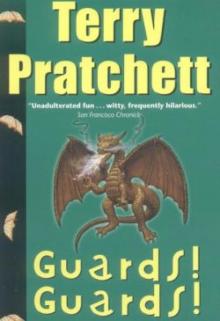 Guards! Guards! tds-8
Guards! Guards! tds-8 Jingo d-21
Jingo d-21 Turtle Recall: The Discworld Companion ... So Far
Turtle Recall: The Discworld Companion ... So Far The Fifth Elephant d-24
The Fifth Elephant d-24 Discworld 39 - Snuff
Discworld 39 - Snuff The Long War
The Long War Only You Can Save Mankind
Only You Can Save Mankind The Science of Discworld III - Darwin's Watch tsod-3
The Science of Discworld III - Darwin's Watch tsod-3 A Blink of the Screen: Collected Short Fiction
A Blink of the Screen: Collected Short Fiction Unseen Academicals d-37
Unseen Academicals d-37 Wings
Wings Making Money d-36
Making Money d-36 A Blink of the Screen
A Blink of the Screen Johnny and the Bomb
Johnny and the Bomb Dodger
Dodger Strata
Strata Discworld 02 - The Light Fantastic
Discworld 02 - The Light Fantastic The Folklore of Discworld
The Folklore of Discworld The Science of Discworld
The Science of Discworld The Unadulterated Cat
The Unadulterated Cat Raising Steam: (Discworld novel 40) (Discworld Novels)
Raising Steam: (Discworld novel 40) (Discworld Novels) The World of Poo
The World of Poo Discworld 05 - Sourcery
Discworld 05 - Sourcery The Witch's Vacuum Cleaner: And Other Stories
The Witch's Vacuum Cleaner: And Other Stories The Science of Discworld II - The Globe tsod-2
The Science of Discworld II - The Globe tsod-2 Small Gods: Discworld Novel, A
Small Gods: Discworld Novel, A Men at Arms tds-15
Men at Arms tds-15 Tama Princes of Mercury
Tama Princes of Mercury The Last Hero (the discworld series)
The Last Hero (the discworld series) The Long Utopia
The Long Utopia Discworld 03 - Equal Rites
Discworld 03 - Equal Rites Terry Pratchett - The Science of Discworld
Terry Pratchett - The Science of Discworld The Long Earth
The Long Earth The Carpet People
The Carpet People The Sea and Little Fishes (discworld)
The Sea and Little Fishes (discworld)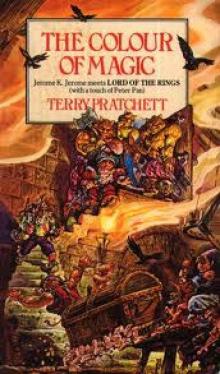 The Colour of Magic
The Colour of Magic Discworld 16 - Soul Music
Discworld 16 - Soul Music The Long Cosmos
The Long Cosmos The Dark Side of the Sun
The Dark Side of the Sun Monstrous Regiment tds-28
Monstrous Regiment tds-28 The Bromeliad 3 - Wings
The Bromeliad 3 - Wings Dragons at Crumbling Castle: And Other Stories
Dragons at Crumbling Castle: And Other Stories Night Watch tds-27
Night Watch tds-27 The Science of Discworld I tsod-1
The Science of Discworld I tsod-1 The Bromeliad 1 - Truckers
The Bromeliad 1 - Truckers The Science of Discworld Revised Edition
The Science of Discworld Revised Edition The Abominable Snowman
The Abominable Snowman Father Christmas’s Fake Beard
Father Christmas’s Fake Beard The Bromeliad Trilogy
The Bromeliad Trilogy A Slip of the Keyboard
A Slip of the Keyboard The Wee Free Men d(-2
The Wee Free Men d(-2 Johnny and the Dead
Johnny and the Dead Mrs Bradshaw's Handbook (Discworld Novels)
Mrs Bradshaw's Handbook (Discworld Novels) Truckers
Truckers The Amazing Maurice and His Educated Rodents d(-1
The Amazing Maurice and His Educated Rodents d(-1 Diggers
Diggers Thief of Time tds-26
Thief of Time tds-26 Science of Discworld III
Science of Discworld III Dragons at Crumbling Castle
Dragons at Crumbling Castle Nation
Nation Darwin's Watch
Darwin's Watch Interesting Times d-17
Interesting Times d-17 The Bromeliad 2 - Diggers
The Bromeliad 2 - Diggers The Science of Discworld II
The Science of Discworld II